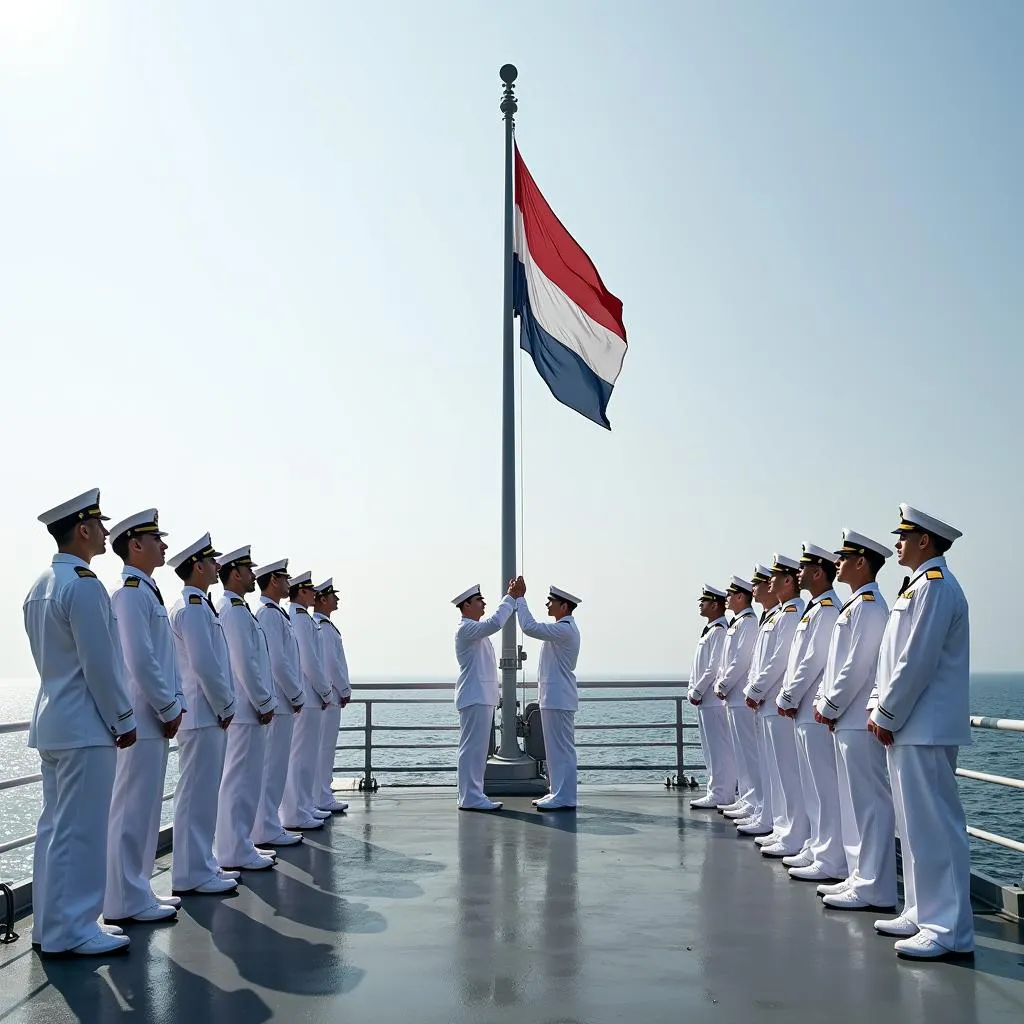“Hoist the colors!” You’ve likely heard this phrase bellowed in movies depicting grand naval battles or seen it referenced in historical texts. But what does this seemingly simple command actually mean? And what’s the fascinating history behind it?
Let’s delve into the world of maritime traditions and explore the significance of hoisting the colors.
A Flag’s Silent Language
On land, we often take for granted the way we communicate. We speak, we gesture, we write. But at sea, things are different. Historically, before the advent of radios and other modern communication technologies, ships relied heavily on visual signals to convey messages. Flags, in particular, played a crucial role in this silent language of the sea.
Each flag, with its unique design and color combination, represented a specific letter, number, or signal. By hoisting different flags in various sequences, ships could communicate a wide range of messages – from identifying themselves to declaring their intentions, signaling distress, or even challenging an enemy vessel.
 Ships hoisting their colors
Ships hoisting their colors
Hoist the Colors: A Call to Action
The phrase “hoist the colors” specifically refers to the act of raising a ship’s ensign – the primary flag that identifies its nationality. This act, seemingly simple, was laden with symbolism and tradition.
- A Symbol of Authority: Hoisting the colors declared a ship’s presence and authority. It was a way of saying, “We are here, and we represent this nation.”
- A Declaration of Readiness: In times of war, hoisting the colors signaled a ship’s readiness for battle. It was a visual challenge to any potential enemy and a rallying cry for the crew.
- A Mark of Respect: During peacetime, ships would hoist their colors as a sign of respect when entering a foreign port or passing another vessel.
The Colors Ceremony: A Time-Honored Tradition
In the days of sail, hoisting the colors was a daily ritual steeped in tradition. At dawn, the colors would be raised with great ceremony, often accompanied by the playing of a national anthem or a specific bugle call. The entire crew would assemble on deck, standing at attention as the flag slowly ascended the mast.
 Colors ceremony on a naval vessel
Colors ceremony on a naval vessel
This ceremony served several purposes:
- Boosting Morale: It instilled a sense of pride and unity among the crew, reminding them of their allegiance to their nation and each other.
- Establishing Routine: The daily raising and lowering of the colors helped establish a sense of order and discipline on board.
- Maintaining Tradition: It was a way of connecting with the long and storied history of maritime tradition.
From Sea to Land: The Evolution of the Phrase
While “hoist the colors” originated in a maritime context, its meaning has evolved over time. Today, it’s often used metaphorically to describe any act of showing support for a cause, team, or organization. For example, you might hear someone say, “Let’s hoist the colors for our local team!” even if there are no actual flags involved.
Hoist the Colors: A Legacy of Tradition
Though the days of sail are long gone, the phrase “hoist the colors” still holds a certain power. It evokes a sense of history, tradition, and the enduring importance of symbols. So, the next time you hear this phrase, take a moment to appreciate its rich maritime heritage and the powerful message it conveys.
FAQ
- What is the difference between an ensign and a flag? An ensign is a specific type of flag that identifies a ship’s nationality. While all ensigns are flags, not all flags are ensigns.
- Why were flags so important for communication at sea? Before the invention of radio, flags were the primary means of long-distance communication at sea. They allowed ships to identify themselves, signal their intentions, and warn other vessels of danger.
- Is the colors ceremony still practiced today? Yes, the colors ceremony is still practiced in many navies around the world. It is a time-honored tradition that serves to instill pride, discipline, and a sense of history among naval personnel.
Need help understanding more about maritime history and traditions? Contact us at Phone Number: 0373298888, Email: [email protected] or visit our office at 86 Cau Giay, Hanoi. Our team is available 24/7 to assist you.

